Light Box Therapy Essentials Guide

Written by
David Nelson
Reviewed by
Prof. Graham Pierce, Ph.D.Light box treatments reset circadian rhythms by reducing melatonin while increasing serotonin levels
Select devices with 10,000 lux and UV filtration that have been cleared for use by the FDA
Start daily sessions at a time that is within 30 minutes of your wake time to optimize circadian realignment
Enhance light box therapy as complementary to walking outside and a regular sleeping schedule, for maximum efficacy
Stop using if you experience any changes in vision, mania, or severe headache
Continually assess changes in your mood/sleep with light box therapy, while continuing to adjust your protocols especially if you reach a treatment plateau
Article Navigation
Light box therapy uses artificial light, mimicking natural sunlight. It is helpful for many people during the gloomy winter months. It works by resetting the body clock. You need to sit close to a special light source each morning for it to be effective.
This guide provides beginners with a safe approach to using light therapies. You will learn how to select a device and utilize it effectively. You will also see the important safety measures that must be taken. These suggestions are the result of many years of assisting individuals who have been affected by seasonal mood disorders.
We focus on three essential elements for success. First, choose an effective light therapy box. Next is keeping regular daily sessions. Lastly, it is about avoiding the common problems that new users encounter. These help improve your mood.
How Light Therapy Works
During the darker months, your body's natural clock gets thrown off, creating what we know as seasonal affective disorder. This clock, called your circadian rhythm, regulates sleep and energy cycles. Less sunlight disrupts this rhythm, resulting in feelings of tiredness and low energy.
Light therapy suppresses melatonin production that makes you drowsy. Being around a light box deceives your brain into thinking it is daytime. It prevents the synthesis of excess melatonin, so you feel more awake and alert.
Morning light exposure also boosts serotonin levels, improving your mood. This natural chemical affects happiness and calmness. Regular sessions create this positive change, helping you feel more like yourself.
Timing is paramount for achieving successful results with light therapy. You should try to schedule your sessions within the first 30 minutes of waking up in the morning to reset your internal clock most effectively. This aligns with your natural rhythm and is more beneficial than afternoon sessions.
Circadian Rhythm Regulation
- Light therapy resets the body's internal clock by simulating natural dawn light patterns
- Exposure to 10,000 lux within one hour of waking aligns sleep-wake cycles with daylight hours
- This synchronization improves energy levels throughout daytime activities and evenings
- Proper timing prevents disruption to natural melatonin release in the evening
- Consistent morning sessions establish stable biological rhythms over several weeks
Melatonin Suppression
- Bright light exposure inhibits daytime melatonin production that causes drowsiness
- The retina detects light intensity and signals the pineal gland to reduce output
- Lower daytime melatonin levels increase alertness and reduce fatigue symptoms
- This effect is most pronounced when using devices with full UV filtration
- Proper positioning at 16-24 inches ensures optimal light absorption
Serotonin Enhancement
- Light therapy stimulates serotonin production in the brain's prefrontal cortex
- Increased serotonin availability improves mood regulation and emotional balance
- This neurotransmitter boost creates antidepressant effects similar to medication
- Therapeutic benefits typically emerge within 7-14 days of consistent use
- Combining light therapy with outdoor walks amplifies natural serotonin effects
Eye-to-Brain Signal Pathway
- Specialized retinal cells detect light and transmit signals to the brain's suprachiasmatic nucleus
- This pathway regulates physiological responses independent of visual image processing
- Morning light exposure optimally triggers neurotransmitter release for alertness
- Proper positioning ensures maximum light absorption through retinal photoreceptors
- This biological pathway activates within 5 minutes of light therapy onset
Long-Term Neuroplasticity Effects
- Consistent light exposure promotes structural brain changes over 4-8 weeks
- Enhanced neural connectivity improves emotional regulation and stress resilience
- These changes persist beyond treatment periods with regular maintenance
- Combined with cognitive behavioral therapy, effects are significantly amplified
- Neuroplastic benefits are measurable through improved mood stability metrics
Choosing the Right Light Box
The first step in choosing a light therapy box is to examine its technical specifications. You want a light source that provides 10,000 lux intensity, the standard of what is effective. To protect your eyes and skin when using it every day, ensure it has ultraviolet filtration.
Screen size is important because larger surfaces can distribute light more effectively. A monitor about 15 inches wide will completely cover what you can see properly. This uniformity contributes to your experience, even if you move slightly during your session, which is not possible with smaller devices.
Consider where you intend to use your light box most. Portable styles are great for traveling or general office use. Stationery versions allow for the distribution of more powerful light for home therapy sessions. Decide which one meets your daily routine.
Always check to see if anything you want to have is medically certified, like FDA approval, before getting it. Approval indicates that the device has been proven safe for use and effectively improves the range of motion. Avoid unmedically certified options that may not actually benefit you.

Carex Day-Light Elite
- Key Specs: 15.5" x 13" screen emits 10,000 lux at 14 inches with UV filtration
- Four adjustable brightness settings from 1,000 to 10,000 lux intensity options
- Wall-mountable design or tabletop use with integrated kickstand positioning flexibility
- Automatic timer shuts off after 15-60 minutes for convenience during sessions
- Warm 4,000K color temperature creates comfortable therapeutic light environment
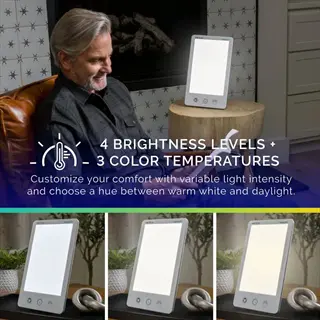
Verilux HappyLight Luxe
- Portability: Compact 9" x 6" screen weighing under 2 pounds for easy transport
- Delivers full 10,000 lux intensity when positioned 6 inches from the user
- Features adjustable color temperature between 3,500K and 5,000K warmth settings
- Countdown timer with automatic shutoff after 5-60 minute session durations
- Budget-friendly option with travel-friendly design ideal for office or hotel use
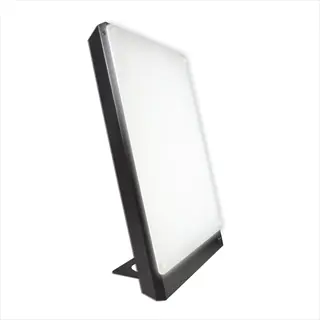
Northern Light Technologies Boxelite
- Design: Minimalist frame with 15" x 12" screen and elegant picture-frame styling
- Emits comfortable 3,500K warm white light at 10,000 lux intensity level
- Includes 7-year warranty coverage for long-term reliability assurance
- Simple one-button operation with instant illumination upon activation
- Extra-long 7-foot power cord provides flexible placement options

Lumie Mini
- Compact Solution: Ultra-portable 8.86" x 6.46" design weighing 1.41 pounds
- Plug-and-play functionality requires no setup for immediate morning use
- Fixed 10,000 lux brightness effective for small spaces and travel needs
- Energy-efficient operation suitable for bedside tables or office desks
- Affordable price point makes it accessible for first-time light therapy users
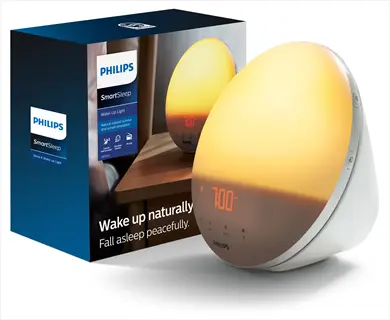
Philips SmartSleep Wake-Up Light
- Dawn Simulation: Gradually brightens room before alarm with sunrise effect
- Lower 300 lux intensity mimics office lighting rather than direct therapy
- 20 adjustable brightness levels with dual alarm clock functionality included
- Secondary light function provides ambient illumination during evening hours
- Ideal for those needing gentle morning awakening alongside light exposure
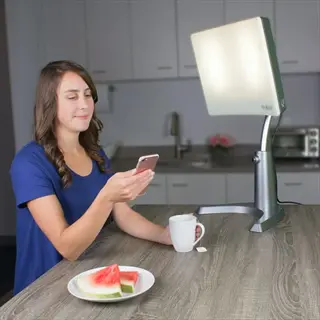
Carex Day-Light Classic Plus
- Reliable Performance: 15.5" x 13" screen delivers 10,000 lux at 12 inches distance
- Weighted horseshoe base provides stability during desk or floor placement
- Two brightness settings with high (10,000 lux) and low (5,000 lux) intensity options
- Replaceable 6-foot power cord offers flexibility for different room layouts
- Airtight cover design prevents dust accumulation on the light surface

Circadian Optics Lumos 2.0
- Vertical Design: Tall 24-inch height projects light downward at eye level
- Three color temperature settings with daylight (6,500K) for optimal therapy
- Touch-sensitive controls adjust brightness from 10% to 100% intensity
- Built-in timer automatically shuts off after 15, 30, or 60 minute sessions
- Sleek aluminum body dissipates heat efficiently during extended usage

Verilux HappyLight Duo
- Floor Lamp Design: Adjustable 45-60 inch height positions light at optimal angle
- Five brightness levels per warmth setting (daylight, warm, cool) for customization
- Daylight mode provides clinically recommended 10,000 lux therapy intensity
- Modern minimalist appearance blends with home or office decor seamlessly
- Sturdy weighted base prevents tipping during movement near the device

Carex TheraLite Radiance
- Multifunctional Design: Integrated clock, temperature display, and Qi charging
- Four adjustable brightness levels with downward-angled light projection
- Folds flat for storage or travel with 8" x 17" x 5" compact dimensions
- Full 10,000 lux intensity at 12 inches distance for therapeutic effectiveness
- Includes USB port for device charging during light therapy sessions
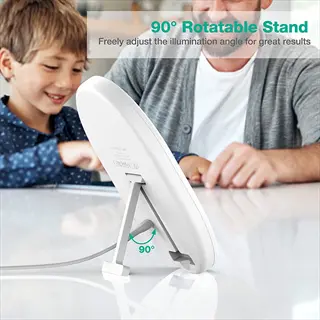
Erligpowht Light Therapy Lamp
- Ultra-Portable: Slim 0.59" profile weighing 10.8 ounces folds for travel
- Four timer settings (15/30/45/60 min) with automatic shutoff functionality
- Three brightness levels with dimming adjustment for personalized comfort
- 10,000 lux intensity provides clinical-strength light therapy benefits
- Includes travel pouch and stand for versatile tabletop positioning options
Step-by-Step Usage Guide
In order to maximise the circadian rhythm reset benefits, begin your session with light therapy within the first 30 minutes after waking. This timing coincides with the peak natural rise of cortisol in the body. Regularity, rather than the period of time during which you can expose yourself to light, is important. Therefore, it is best to make this a habit you engage in each morning as part of your routine.
Place your light box 16 to 24 inches away from your face, depending on size. Larger boxes work well when placed at arm's length, while smaller models require a closer distance. Angle it slightly downward towards your face to avoid glare and protect your eyes during the session.
Keep your eyes open when reading or breakfasting during the sessions. Don't focus absolutely on the light source, but look at it periodically without maintaining a fixed gaze. Meditation and similar activities with the eyes closed limit the efficiency of light absorption.
Suppose you have not noticed any changes in your mood after two weeks. In that case, the next step is to gradually increase the length of your sessions by either moving them earlier in the day or by splitting them into morning and afternoon sessions. If these modifications do not alleviate your symptoms, consult your doctor for further evaluation.
Morning Timing
- Begin sessions within 30 minutes of waking to maximize circadian rhythm reset
- Consistent daily timing reinforces biological clock synchronization effects
- Morning sessions prevent interference with natural melatonin production at night
- Avoid sessions after 10 AM to reduce potential sleep disruption in evenings
- Set daily reminders to maintain regular treatment schedule consistency
Positioning Setup
- Place light box 16-24 inches from face depending on manufacturer specifications
- Position device slightly below eye level with downward angle to reduce glare
- Ensure light covers peripheral vision without requiring direct eye contact
- Adjust distance when using smaller devices like Lumie Mini to 6-8 inches
- Maintain consistent positioning throughout entire session duration
Session Activities
- Keep eyes open while reading physical books or printed documents nearby
- Work on laptops positioned below light box to maintain proper eye level
- Eat breakfast while facing device to integrate therapy with morning routine
- Avoid closed-eye activities like meditation which reduce light absorption
- Periodically shift gaze within light field without staring directly at lamps
Duration Protocol
- Start with 20-30 minute daily sessions for initial 10-14 day adaptation period
- Gradually increase to 45 minutes if mood improvements plateau after two weeks
- Split sessions: 30 minutes morning + 15 minutes afternoon for resistant cases
- Never exceed 60 minutes daily without medical supervision due to side effect risks
- Use built-in timers to automatically end sessions at preset intervals
Troubleshooting Adjustments
- Reduce duration to 15 minutes if experiencing headaches or eye strain
- Increase distance by 4-6 inches for models causing agitation or irritability
- Consult ophthalmologist immediately if experiencing persistent vision changes
- Switch to dawn simulators like Philips SmartSleep for sleep-onset issues
- Discontinue use and seek medical advice if manic symptoms develop
Safety and Side Effects
There are typically only mild temporary side effects such as eye strain or headaches. These usually subside as the body responds within the first week. Still, if discomfort persists, the time of the session should be cut down. Serious reactions are rare when used properly.
Some medical conditions need to be evaluated before initiating light therapy. These include: bipolar disorder not on mood stabilizers recent eye surgery and retinal disorders. Even some medications or classes of medications such as tetracycline antibiotics can pose dangerous photosensitivity.
Special precautions are necessary for individuals in high-risk groups throughout treatment. Patients with lupus and people on psychiatric medications should have shorter initial treatment sessions. Older adults and children under the age of 12 must have doctor supervision for every session of their therapeutic journey.
Cease therapy right away if you experience emergency symptoms such as changes in vision or mania. Skin rashes and breathing difficulties are also indicators of urgent issues. Rather than attempting to adjust settings on your own, pursue medical care.
Absolute Contraindications
- Bipolar disorder without mood stabilizer medication
- Retinal diseases like macular degeneration or diabetic retinopathy
- Recent eye surgery or untreated glaucoma conditions
- Photosensitizing medications: tetracycline antibiotics, antipsychotics
- Herbal supplements like St. John's Wort increasing light sensitivity
High-Risk Groups
- Individuals with lupus or porphyria causing extreme photosensitivity
- People taking lithium or other psychiatric medications
- Elderly patients with pre-existing eye conditions
- Pregnant women without obstetrician approval
- Children under 12 except under pediatric supervision
Precautionary Measures
- Annual comprehensive eye exams for long-term users
- Maintain minimum safe distance specified by manufacturer
- Avoid direct eye contact with light source during sessions
- Verify UV filtration certification before purchase
- Consult physician before combining with antidepressant medications
Device Safety Checks
- Inspect for damaged cords or cracked light surfaces monthly
- Ensure proper ventilation to prevent overheating during use
- Clean surfaces with dry microfiber cloth weekly
- Verify automatic shut-off timers function correctly
- Replace bulbs according to manufacturer lifespan guidelines
Medication Interactions
- Antidepressants may require dosage adjustment when combined with light therapy
- Diuretics can increase photosensitivity risk during treatment sessions
- Retinoid acne medications heighten light sensitivity effects substantially
- Consult pharmacist about OTC drugs like antihistamines affecting light tolerance
- Never combine with photosensitizing chemotherapy agents without oncology approval
Maximizing Results
Utilize a simple 1 to 10 scale journaling system to log mood shifts daily. Also note the quality of your sleep and morning, noon, and evening levels of energy. Wearable devices are available to help track your patterns. This log will indicate whether or not light therapy is effective for you.
Suppose you have experienced a consistent lack of results for several weeks. In that case, you may want to consider trying a different approach. You may lengthen the sessions or divide them into morning and afternoon sessions. You may also try to do the sessions earlier if you are experiencing an energy crash. If problems persist, consider working with a healthcare professional.
Incorporate therapies with habits to enhance benefits. Take walks outside close to your morning session time. Consume serotonin-containing foods for breakfast, such as nuts and eggs. Have consistent sleep time (including weekends) for circadian stability.
After improvement, sustain gains using shorter daily sessions. Start therapy preventively each fall before symptoms start. Please change the filters in your device yearly and replace them every other year with a new unit. Schedule seasonal eye exams to ensure your eyes are always safe.
Progress Tracking
- Maintain daily journal documenting mood changes on 1-10 scale
- Track sleep duration and quality using wearable devices or apps
- Note session consistency including exact start times and durations
- Record energy levels at three daily intervals: morning, noon, evening
- Compare weekly averages to identify improvement patterns
Therapy Adjustments
- Increase session duration to 45 minutes if no improvement after 10 days
- Add afternoon sessions for 15 minutes if morning energy crashes occur
- Switch to dawn simulation devices for persistent sleep-onset issues
- Adjust light angle to 45 degrees if experiencing glare discomfort
- Combine with CBT for treatment-resistant seasonal mood changes
Lifestyle Synergy
- Take 20-minute outdoor walks within 2 hours of morning sessions
- Consume serotonin-boosting foods like eggs, salmon and nuts at breakfast
- Maintain consistent sleep schedule including weekends for circadian stability
- Reduce evening blue light exposure from screens after sunset
- Practice mindfulness meditation during sessions for dual benefits
Long-Term Maintenance
- Continue reduced 15-minute daily sessions after symptom remission
- Use therapy preventively starting each fall before symptoms appear
- Replace UV filters annually according to manufacturer specifications
- Schedule seasonal ophthalmologist check-ups for eye health monitoring
- Rotate between multiple devices to extend product lifespan
Troubleshooting Plateaus
- Verify light intensity with lux meter if device effectiveness diminishes
- Replace bulbs after 10,000 hours or when brightness visibly decreases
- Consider medication consultation if no improvement after 4 weeks
- Assess for non-seasonal depression requiring different interventions
- Try alternate morning times if work schedule disrupts consistency
5 Common Myths
Many people mistakenly feel that light therapy alone can cure clinical depression without the assistance of pharmacological or other methods
Light therapy is effective in relieving seasonal affective disorder symptoms, but is no cure for clinical depression. Light therapy should be used together with some professional medical treatment such as cognitive-behavioral therapy or antidepressant drugs under the supervision of a physician for the complete management of depression since it often takes multi-faceted methods to overcome its biological and psychological factors simultaneously.
There is a widespread misconception that using light boxes with intensities exceeding 10,000 lux provides faster relief from seasonal affective disorder
Clinical research confirms 10,000 lux is the optimal intensity balancing effectiveness and safety. Higher intensities increase risks of side effects like eye strain without accelerating benefits. Therapeutic results depend on consistent daily exposure timing, not exceeding the scientifically validated 10,000 lux standard, which provides sufficient illumination for circadian rhythm regulation when used properly.
Some consumers incorrectly assume blue LED lights deliver therapeutic benefits equivalent to full-spectrum white light devices
Blue LED lights lack the comprehensive spectrum of clinically validated light therapy devices. White light with UV filtration replicates natural sunlight wavelengths that safely regulate circadian rhythms and serotonin production. Blue light poses higher retinal damage risks and isn't FDA-cleared for seasonal affective disorder treatment due to insufficient evidence regarding efficacy and long-term ocular safety compared to approved devices.
A widespread misunderstanding suggests that intermittent treatments using light therapy are adequate to attain winter mood improvements
Consistent usage on a daily basis is necessary, since light therapy resets the circadian rhythmic cycles gradually through cumulative exposure. The sporadic and infrequent use cannot properly establish the biological rhythm necessary for the continued benefit. Most people need fourteen to twenty-one consecutive days of daily treatments before they are able to experience significant changes, and continued maintenance is an absolute necessity during the dark months to avoid a recurrence of symptoms.
Some consumers mistakenly believe that all light therapy boxes produce the same results regardless of technical specifications
The therapeutic effectiveness of these devices is variable, depending on the equipment length, light distribution patterns, and safety certifications. Devices without the proper UV filtering or medical certification measures may be ineffective or dangerous. Clinically tested devices provide for uniformity of light distribution, and eye protection, which is essential in obtaining measurable psychological benefits are found in the clinical tested devices, whereas the poorly produced or uncertified instruments may provide for an erratic light supply which precludes beneficial results from treatment.
Conclusion
Light box therapy is a potent natural solution for seasonal mood problems that does not involve the use of drugs. It helps bring the rhythms of your body back into alignment without drugs. Many find that it provides a good rest of their winter experience by imparting energy and emotional balance without the danger of drugs.
Keep in mind the essential elements we have covered for the best results. Choose a certified device with proper intensity. Use it at the correct morning time. Follow safety guidelines. These core practices make light therapy effective for seasonal affective disorder.
Consistency remains the most important aspect of your therapy journey. Daily sessions will build cumulative benefits that irregular therapy cannot replicate. Even if you feel better, continue your daily routines so that your gains persist even through the challenging months ahead.
Begin implementing these recommendations tomorrow morning. Place your light box within 30 minutes of awakening. Then, track your mood changes each week. Now you can take proactive steps for your winter wellbeing, starting with your next sunrise.
External Sources
Frequently Asked Questions
What does light box therapy do?
Light box therapy regulates circadian rhythms by simulating natural sunlight. It suppresses melatonin production to reduce drowsiness and boosts serotonin to improve mood. This non-invasive treatment effectively manages seasonal affective disorder symptoms through daily exposure sessions.
How long should light therapy sessions last?
Optimal session duration depends on individual response and device specifications:
- Begin with 20-30 minutes daily during initial adaptation weeks
- Gradually increase to 45 minutes if mood improvements plateau
- Never exceed 60 minutes without medical supervision
- Use automatic timers for consistent daily scheduling
Can light boxes replace sunlight for vitamin D?
No, light therapy devices cannot stimulate vitamin D production. They emit visible light without UVB rays required for skin-based vitamin D synthesis. These devices are designed specifically for circadian regulation and mood enhancement, not nutritional supplementation.
What safety certifications should light therapy devices have?
Prioritize devices with medical validations ensuring safety and efficacy:
- FDA clearance for seasonal affective disorder treatment
- UV filtration certification to protect eyes
- Compliance with international electrical safety standards
- Manufacturer warranties covering performance defects
Why isn't red light recommended for seasonal affective disorder?
Red light lacks the full-spectrum wavelengths necessary for circadian regulation. Clinically validated devices use white light that mimics natural sunlight, safely regulating melatonin and serotonin without the retinal strain risks associated with narrow-band red light exposure.
How soon do light therapy benefits appear?
Most users notice initial improvements within consistent daily use:
- Subtle energy boosts may occur in the first week
- Mood stabilization typically emerges after 10-14 days
- Full therapeutic effects develop over 3-4 weeks
- Track progress daily using mood journals
Can you use light therapy with antidepressants?
Light therapy can complement antidepressant medication but requires medical supervision. Always consult your physician before combining treatments, as some medications increase photosensitivity. Dosage adjustments may be necessary when integrating both therapeutic approaches.
What positioning ensures effective light exposure?
Proper device placement maximizes therapeutic benefits:
- Position 16-24 inches from face per manufacturer guidelines
- Angle slightly downward to minimize glare
- Ensure light covers peripheral vision
- Maintain consistent distance throughout sessions
When should seasonal light therapy begin?
Start preventive therapy before seasonal symptom onset:
- Begin in early fall for winter seasonal affective disorder
- Continue daily sessions through darker months
- Use shorter maintenance sessions after symptom remission
- Resume full protocol at first symptom recurrence
What activities are compatible during sessions?
Engage in low-intensity activities that keep eyes open:
- Reading physical books or printed materials
- Eating breakfast while facing the light
- Working on laptops positioned below eye level
- Avoid closed-eye activities like meditation

